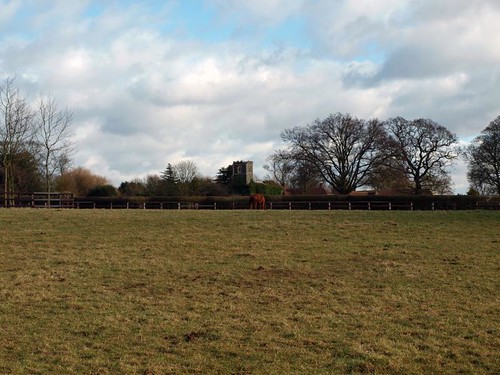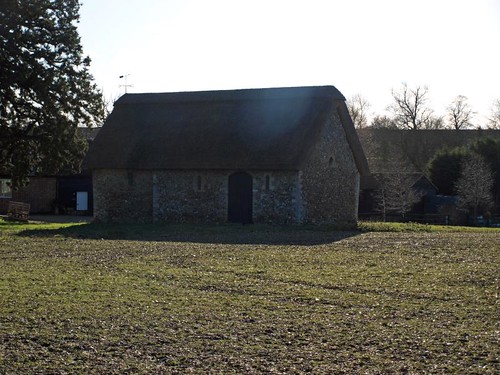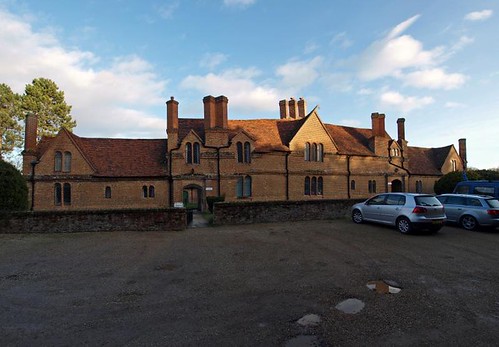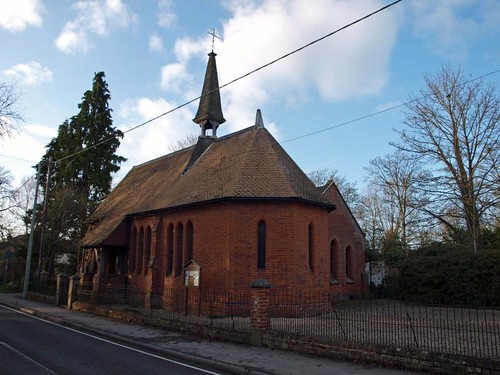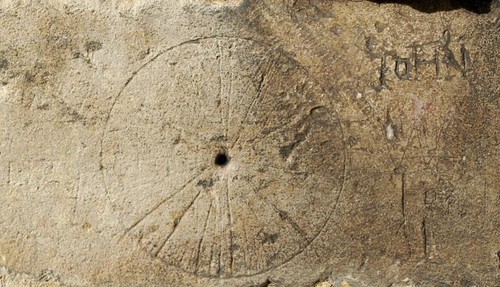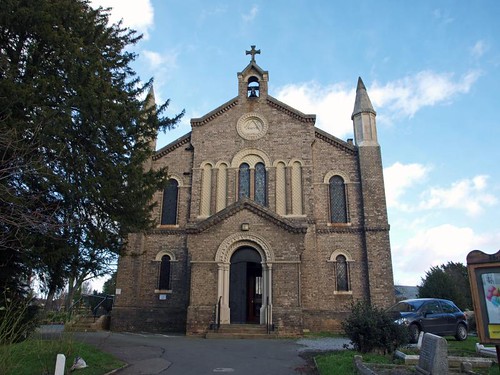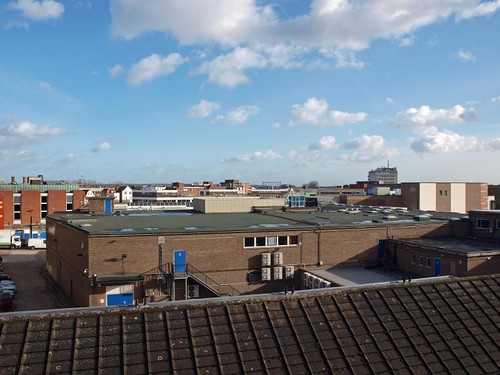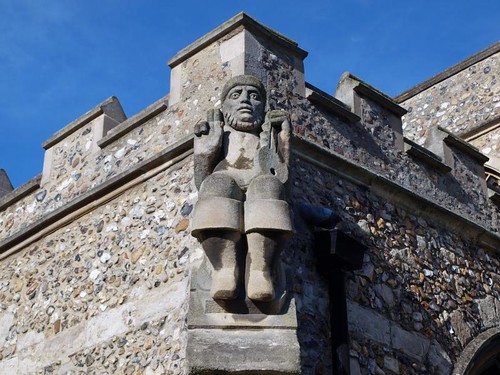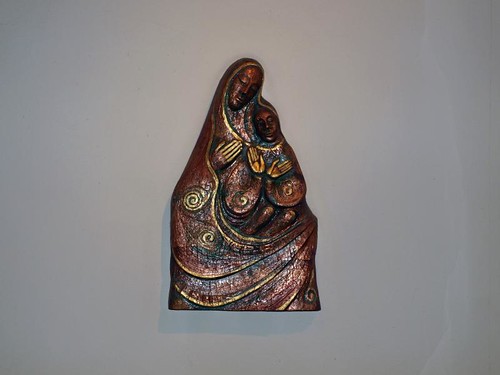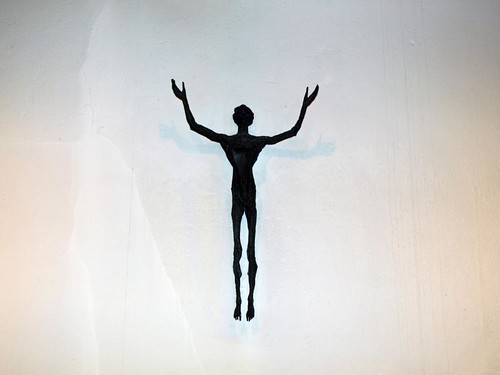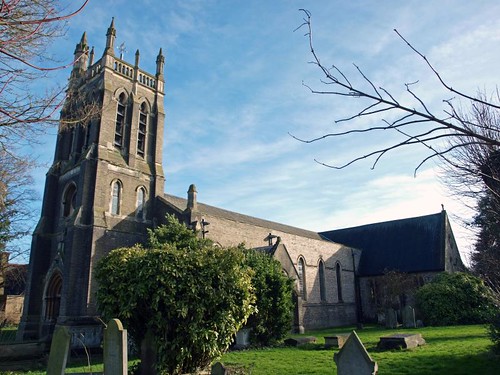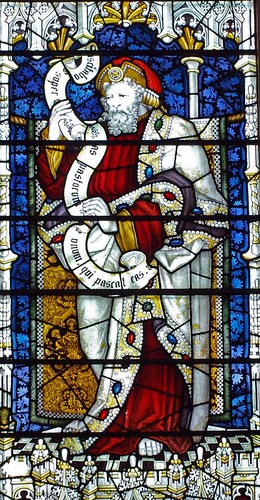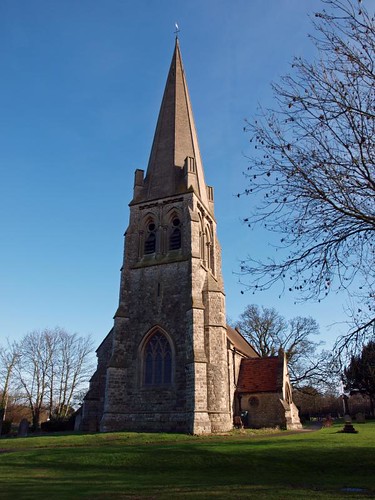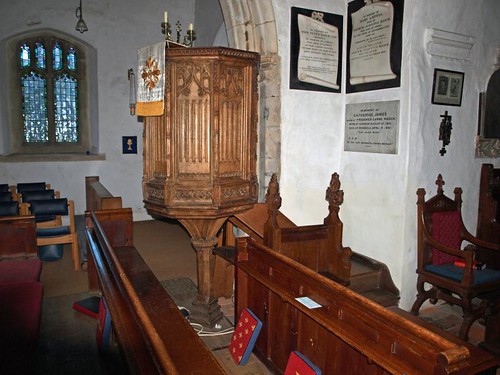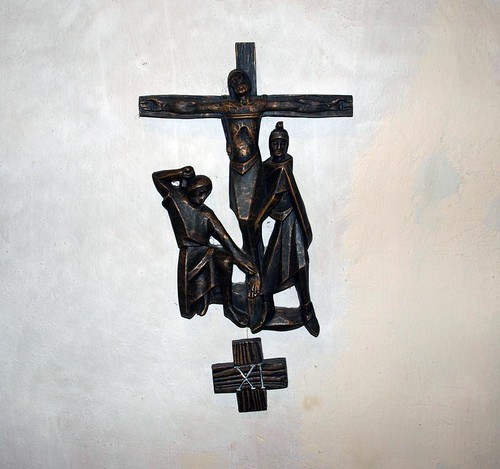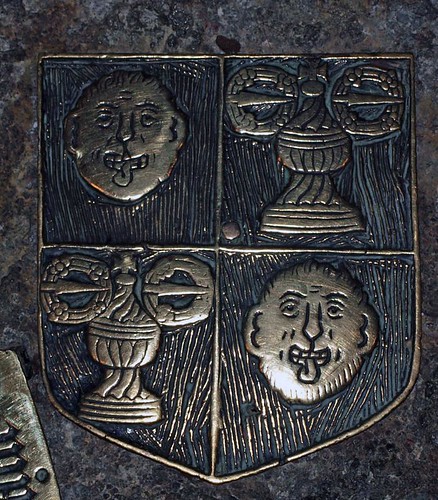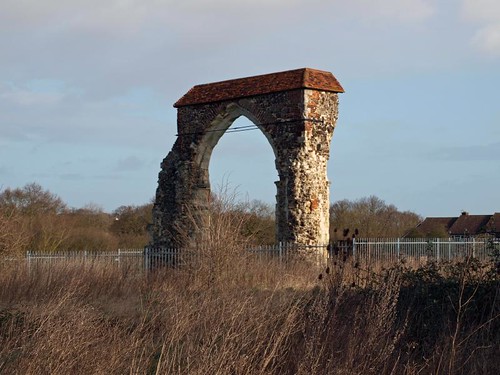Chelmsford Cathedral, or more properly St Mary the Virgin, St Peter and St Cedd, was closed for business when I arrived due to the 60th anniversary service to commemorate the Great Flood of 1953 and the presence of Princess Anne so I went for a walk around town to kill time until the service finished.
I don't know Chelmsford well but I have to say that, to me, it made Harlow look like a lovely place to live.
When I finally got into the Cathedral the horrors of without were soon forgotten, overwhelmed by the loveliness of this intimate building (it's smaller than several parish churches I've visited but then until 1914 it was a parish church and quite a large one at that) and it's embracement of modern art - a wonderful mix of old and new makes St Mary rather special.
CATHEDRAL or ST MARY. Chelmsford was raised to the rank of a cathedral town in 1913. But the church will, whatever adjustments can be made, remain the parish church of a prosperous late medieval town. Perhaps Liverpool and Guildford have been wiser, and Coventry is being wiser, to build new temples. The best impression of the building is the outside from the SE, with the commanding late C15 W tower, the spectacular S porch, the nave, aisle and chancel and the new E end of Sir Charles Nicholson’s, a little higher than the chancel. Its date is 1923, but Sir Arthur Blomfield’s E window of 1878 was re-used. The W tower has set-back buttresses, but the angles are chamfered. The battlements are decorated with flushwork and carry eight small pinnacles. The charming open lantern is of 1749 when the leaded needle spire was also rebuilt. W doorway with ogee gable and tracery and shields in the spandrels, three-light W window, three-light bell openings. The rest of the church over-restored. The outer N aisle and N transept are an addition of 1873. The chapter-house, muniment room, and vestries, very much more attractive in design, date from 1926 and are also due to Sir Charles Nicholson. On the S side the S porch has plenty of flushwork decoration and inside a ceiling re-using blank tracery perhaps from bench-fronts. E of it the last two bays of the nave are alone ashlar—faced. The interior reveals one earlier restoration, 1801-3 by John Johnson (see below). He rebuilt the late C15 piers with their characteristic lozenge shape and their mouldings and on the S side used Coade & Seely’s Coade stone for the purpose. The clerestory windows were also renewed by Johnson. But the prettily ribbed, coved Tudor ceiling of the nave is of 1899. The aisles embrace the tower, the chancel aisles the chancel. The N chapel opens in an early C15 arcade of two bays which has an unusual shape: round arch divided into two pointed arches with openwork panel tracery in the spandrel. The thin pier has four shafts and four hollows in the diagonals. - ALTAR by Wykeham Chancellor, 1931. - BISHOP'S THRONE with high Gothic canopy by Sir Charles Nicholson. - PROVOST’S STALL with simpler square canopy by Wykeham Chancellor 1936. - COMMUNION RAIL with thick openwork foliage, c. 1675, said to come from Holland. - PULPIT 1872. - PAINTINGS on the chancel walls. By A. Hemming, 1904. - STAINED GLASS. Mostly by A. K. Nicholson and rather prosaic with its realistic figures on a ground of clear glass. - E window by Clayton & Bell, 1858. - PLATE. Cup of 1620; two Flagons of 1697; Alms-dish of 1700; two Patens on foot of 1707. - MONUMENTS. Thomas Mildmay, erected 1571, a standing wall monument of a curious shape, and without any major figures. Base with colonnettes and small figures of kneeling children. Above this zone one with two steep triangular and one semi-circular pediment and above that zone a big ogee top with strapwork decoration. - Robert Bownd D. 1696, (N aisle), with fine flower garlands. - Earl Fitzwalter (Benjamin Mildmay) D. 1756. Large standing wall-monument with an oversized urn in the centre flanked by Corinthian columns, and big cherubs standing to the l. and r. Signed by James Lovell. - Mary Mash D. 1757. Of various marbles with an urn and fine Rococo decoration.
CHELMSFORD. It is the county town and has a cathedral, it stands on two rivers, and it has one of the finest of those wonderful spectacles of our 20th century, the towering masts of the Wireless Age. It has grown rapidly from a quiet agricultural centre to an energetic modern town, and it is its pride to have been the first of all our towns to light the streets with electricity.
To the last generation Chelmsford was a town with maltings, corn mills, breweries, and tanneries, serving the county and beyond by a short canal to the Blackwater, and conducting all this trade on the smallest draught of water of any river or canal in our island. To us it is a town of ironfounding and engineering works, of factories making ball-bearings and arc lights, and most of all it is the heart of that great wonder world built up by Marconi.
For miles in this level country the high Marconi masts draw the traveller’s eye, their warning lights twinkling at night 450 feet above the town. They look down on great works covering 25,000 square yards, and on Marconi College where students come from everywhere to keep abreast with the latest developments in the miraculous wireless world. Their playing-fields have added to the delightful open spaces in which Chelmsford is so happy, thanks partly to Mother Nature who has sent her two rivers (the Chelmer and the Can) to mingle their waters in the city, and another little stream outside. Their banks are lined with willows and are very pleasant places. The Roman road to Colchester runs through the town at a point where the rivers were fordable, an 18th century bridge taking the old road over the Can, while our modern engineers have bypassed it on 550 yards of concrete arches.
The old village of Moulsham, with a few of its 17th century cottages left, has been drawn into the town. Here is all that is left of the old Friary which had become the home of King Edward’s School when its roof fell in in 1663. The school now stands in lovely grounds north of the city. The most famous scholar it has known was Philemon Holland, “the translator-general of his age.” His first years were unhappy, for his father was a Protestant and had to flee to the Continent with Miles Coverdale when Mary Tudor was crowned. On his return the father became rector of Great Dunmow and sent the boy here to school. He wrote much, and the dull poet Pope made cynical fun of the groaning shelves on which his works stood. He would be very familiar with the overhanging timber shops and cottages in Moulsham Street, one of them still with a beam carved in the 15th century.
The heart of Chelmsford lies between its two rivers. It is a town of old and new, with a medieval church standing by the dull backs of the old Shire Hall, greeting across low roofs the splendid modern County Hall which governs Essex, and administers more than one area of Greater London bigger than Chelmsford. The County Hall fronts the pathway slanting through the churchyard and is striking with pilasters five storeys up, and below them (carved on filt spaces) the stone figure of a man carrying a scroll and a woman with a child in the rays of the sun.
Before the coming of the County Hall, with its five storeys of snow-white stone, the Shire Hall’s 18th century front held sway in the streets, with four pillars crowned with a pediment on which are figures of Justice, Wisdom, and Mercy. The hall took the place of an older court which was infamous 300 years ago for its trials of witches and its persecution of nonconformists; it is recorded that one day in 1645 nine poor women were sent to the stake from here.
The City Council, too, is providing itself with handsome buildings, the first to be completed (in 1935) being the public library in Duke Street, with a great arch of white stone at its entrance. The whole of the ground floor is devoted to the housing of 32,000 books, and to lecture rooms, and above are the rooms from which the Mayor and his council govern the city. Close by is the peace memorial, a solid obelisk in stone rather like the Cenotaph in Whitehall; on the back in bronze letters are the words Our Glorious Dead.
Near the Shire Hall stands the Corn Exchange, and in the square outside is the bronze statue of a Chelmsford boy who grew up to be a judge and won fame by his courage in defending Queen Caroline. He was Sir Nicholas Tindal, who became Chief Justice before he died; we see him sitting, and his statue is by Edward Baily. Where he sits once flowed a spring over which was a handsome conduit now at the other end of High Street. Here all has been changed save one or two inns, the Saracen in which Anthony Trollope used to write, and the Spotted Dog with its remarkable courtyard.
For relics of old Chelmsford we come to the mansion in the park at the London end of the town; it is known as Oaklands House, and stands in splendour amid lawns and cedars, a 19th century house filled with delightful things. There is a collection of 1000 British birds among which we noticed one of the only two needle-tailed swifts which have been captured in England. There is the collection of that remarkable man John Salter, a worldwide Nimrod who died in our time; very real are his stuffed beasts, especially the lion and a group of wolves. The lover of the story of Essex will delight in the flat stone on which the Bronze Age men sharpened their axes, the dug-out canoe in which they went fishing, the huge Roman vase found at Maldon, the Roman and the Saxon javelins from Witham. The art of medieval England is seen on ten panels from a screen of Latchington church with painted saints in red and green robes, and there is a small picture gallery where we found 80 watercolours of Essex churches and houses by Bennett Bamford, a lovely Turner, and landscapes by those two immortals who loved this countryside, Constable and Gainsborough. Watching over the treasures in one of these rooms is the sculptured head of a priest who shepherded his flock in Egypt about 40 centuries ago. The museum is happily situated for the schools of southern Chelmsford, with their modern buildings and spacious playing-fields for nearly 2000 scholars. They are an honour to the city.
Chelmsford’s church has been made a cathedral in our time, but time has conspired to hide it. One splendid thing it has done, for it has taken away the ugly railings round it and laid flat all the gravestones, an example we should like to see copied everywhere. By the churchyard stands the only house of dignity here, Guy Harlings, where the Provost lives; it has panelling 400 years old, and carved heads looking down on the hall from a Tudor frieze.
The church has stood about 500 years and has two fine things, a 15th century tower with a slender lead spire on an open cupola, and a richly panelled two-storeyed porch, the white stone of the panelling set in flint and continued as pinnacles. Much of the church has been rebuilt and the chancel has been lengthened. It has a clerestory supported by an arch which is perhaps unique, being divided in two with its centre spandrel made strong by upright stone bars. The most striking thing in the sanctuary is the elegant bishop’s throne, with light tracery soaring towards the roof; it is in memory of the rector who became Bishop of Colchester in 1894, Henry Johnson, whose grave in the churchyard is marked by a tall cross. Looking down on the altar from a niche in the wall is a statue of Chelmsford’s first bishop, John Watts-Ditchfield; it is a stately figure of this famous social reformer.
One of the screens is in memory of Frederick Chancellor, who was 93 when he died at the end of the Great War. He was the last original member of the Essex Archaeological Society, which gave this fine screen. His great book with hundreds of exquisite drawings of monuments in Essex churches has few equals in any county.
At the west end of the cathedral are four peace memorials: a golden bell to 44 Essex ringers, most of whom must have had a pull at the 12 bells here; a solemn figure holding a gun reversed in memory of 257 Essex yeomen; a fine window of St Michael between St George and St Nicholas in memory of 99 men of the parish; and an elaborate sculpture in memory of 55 Essex clergy and their sons who perished in the war and whose monument has these lines:
For unto them we know is given
A life that bears immortal fruit.
One pathetic tablet on the tower arch tells us of another hero, Scout Dawson of the Cathedral Troop, who gave his life at 16 while trying to save a Belgian Scout from drowning.
It may be thought that the cathedral lacks the grace of such a church as Thaxted, and the perfection in stone of such a church as Saffron Walden, but it had introduced when we called a fine note of colour in a series of modern windows by A. K. Nicholson; they represent the great psalm of praise. One of the older windows in the style of William Morris shows a group of angels as Faith, Hope, and Love, helping a pilgrim on the way to heaven. The 19th century pulpit has white and coloured marbles, and on the walls are the flags of the old Essex Militia, woven for the companies which marched about the county when Napoleon was expected.
On a big brass are the names of 41 Mildmays buried here from 1544 to 1798, and in the corner of a chapel is the great tomb of the founder of this vigorous line, Thomas. Henry the Eighth gave him the manor of Moulsham, and as his own good deed for the town he founded the grammar school; he had eight sons of his own to educate as well as seven daughters. He founded the almshouses, too, and as his wife died before him he himself probably built this rich tomb in which he lies with her.
The tomb is enriched with architectural features at that time being introduced from Italy, and the decoration carries the eye up to a golden ball perched on a Greek capital. The central panel is painted with heraldry, and at each end are sculptured groups of mourners, kneeling, Thomas himself with his sons, and his wife with the daughters. It was one of the sons who added to the tomb a decorated arch in honour of the “fifteen pledges which Thomas and Avice had of their prosperous love.” One of the sons on the tomb was Walter Mildmay. As the father had grown rich as receiver of the surrender of the monasteries (when Henry the Eighth is said to have received 15 millions of money), so the son controlled the revenues of Edward the Sixth, and continued to serve Mary and Elizabeth. He was a pious man, and generous to education, for he founded Emmanuel College, Cambridge, and it was to this that Queen Elizabeth referred on meeting the Chancellor soon after. “I hear you have erected a Puritan foundation,” said the Queen. “No, madam,” said the Chancellor, “but I have set an acorn which, when it becomes an oak, God alone knows what will be the fruit thereof.” Sir Walter does not lie here, but in the famous church of St Bartholomew the Great, which looks out on Smithfield, the scene of the burning of the martyrs in his day.
A neighbour of the Mildmays in the 17th century has his portrait engraved on marble in the south chapel; it is like a very curious brass and shows Matthew Rudd with two sons kneeling at prayer facing his wife and three daughters. On the desk between them are two books, and with a foot on each book stands Death, pointing a barbed shaft at these people.
The porch by which we come and go has about 20 heads looking down from the medieval panels of its timber ceiling, and above it is a library of books left to the church in the 17th century; we see them from the nave through open panelling of stone. In one of the books we read that miracle plays were performed in this wide nave as late as 1576.
Two sons of Chelmsford winning fame in the 18th and 19th centuries were Joseph Strutt and Wilson Barrett, one delighting his generation by his description of the people’s pastimes, the other entertaining his generation on the stage. Joseph Strutt, born in 1749, was the son of a rich miller and became famous as an antiquarian, his chief work (many times reprinted since its first publication in 1801) being the monumental Sports and Pastimes of the People of England. Wilson Barrett, born at the Manor Farm here in 1846, started his career as a printer’s lad, but soon migrated to the stage, making his first appearance at Halifax when he was 18 and remaining faithful to the theatre for 40 years, until a few weeks before his death in 1904. At his best in melodrama, he achieved many successes on the London stage, and Victorians vigorously applauded his performances, particularly in The Silver King and The Sign of the Cross -a play which drew crowded audiences for years to see Wilson Barrett and Maud Jeffries, a beautiful actress from Tennessee.
Flickr.

